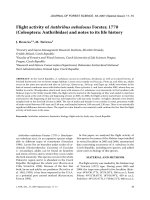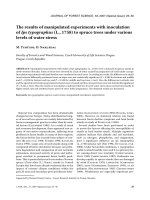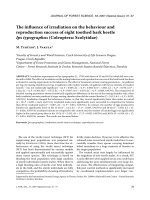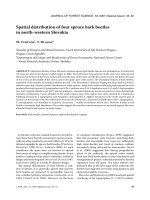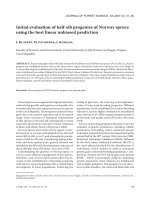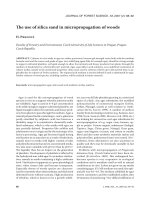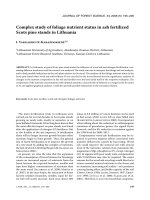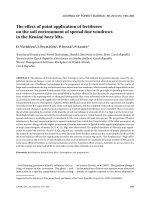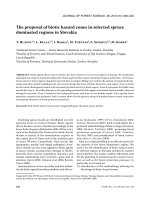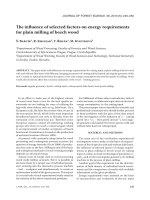Báo cáo lâm nghiệp: " An estimation of willingness to pay for asparagus (Asparagus racemosus Willd.) collectors in Makawanpur District, Nepal" ppsx
Bạn đang xem bản rút gọn của tài liệu. Xem và tải ngay bản đầy đủ của tài liệu tại đây (430.09 KB, 7 trang )
J. FOR. SCI., 54, 2008 (3): 131–137 131
JOURNAL OF FOREST SCIENCE, 54, 2008 (3): 131–137
Nepal has high levels of endemism in its endog-
enous flora and fauna carrying high non-timber
use and value. ough Nepal covers 0.1% of the
earth’s landmass, it ranks 25
th
in global biodiversity
importance due to its unique bio-geographic loca-
tion, altitudinal variation, diverse topography, cli-
matic conditions and ecological habitats (BPP 1995).
ere are > 6,500 flowering species; > 700 species
are used as Non-timber Forest Products
1
(NTFPs)
with ~100 species of commercial value (BPP 1995;
E 1996). Annually a large quantity of NTFPs
(10,000–15,000 t) is exported in raw form, mainly
to India (M 1995), worth about US$ 26.5 M a
year (ANSAB 1998), or ~ 4% of the national GDP of
Nepal (K et al. 1999).
One of the highly traded species from Nepal in
general and from Makawanpur district (Fig. 1) in
particular is asparagus (M 2002; M
et al. 2006). In 1998/99, Nepal exported 94.3 t of
asparagus which increased dramatically by 202% to
190.3 t in 2000/01. Similarly, the Makawanpur dis-
trict, one of the 75 districts of Nepal, exported 43.2 t
in 1998/99 and 74.9 t in 2000/01 (DFO 2002). Of the
total amount of asparagus exported from Nepal, the
An estimation of willingness to pay for asparagus
(Asparagus racemosus Willd.) collectors
in Makawanpur District, Nepal
T. N. M
1
, J. M
2
, G. C
3
1
Australian Centre for Sustainable Catchments (ACSC), University of Southern Queensland
(USQ), Toowoomba, Australia
2
Faculty of Education and ACSC, USQ, Toowoomba, Australia
3
Faculty of Business and ACSC, USQ, Toowoomba, Australia
ABSTRACT: e collection and sale of asparagus (Asparagus racemosus Willd.) is a major source of income for Praja
and Tamang castes around the Royal Chitwan National Park (RCNP) in Nepal. However, the forests where asparagus
is harvested are becoming depleted threatening the livelihood of collectors. To address this issue, at sustainable har-
vesting practices, the research reported here applied the contingent valuation method (bidding game) and estimated
the average willingness to pay (WTP) of collectors to two asparagus collection scenarios. In the first scenario, if forests
under the Department of Forests jurisdiction were managed for sustainable harvesting at 1995 rates, the average WTP
of collectors was 4.4 NR/kg. In the second scenario, if the forest in the RCNP is managed in such a way that both the
current harvesting rate of asparagus is sustained and they are legally allowed to collect asparagus at the present rate,
the average WTP of collectors was 8.35 NR/kg. Consequently, there is a good chance of earning revenue for the govern-
ment and sustaining the livelihood of asparagus dependents by the sustainable management of the Department’s and
the National Park’s forests and giving legal permissions to collect asparagus from the National Park, which would have
happened anyway but with financial and legal risks to collectors.
Keywords: Asparagus racemosus; willingness to pay; contingent valuation method; Praja; Tamang
1
Definitions of NTFPs vary, but in Nepal fuelwood, fodder and timber are not regarded as NTFPs (MFSC 1988). More notably,
the terms Minor Forest Products (MFPs), NTFPs, Jaributi, and Medicinal and Aromatic Plants (MAPs) are used interchangeably.
For the purpose of this research, NTFPs refer to the traded parts of plants other than timber, fuelwood and fodder.
132 J. FOR. SCI., 54, 2008 (3): 131–137
contribution of the Makawanpur district was 45.8%
and 39.4% in the fiscal year 1998/99 and 2000/01,
respectively. Although the share of the Makawanpur
district to the country dropped by 6.4% from 1998/99
to 2000/01, the quantity traded from the district dur-
ing the same period increased by 73%.
In Nepal, government forest ownerships and juris-
dictions are either through the Department of Forests
(DF) or the Department of National Parks and Wild-
life Conservation (DNPWC). About 39% and 18%
of the total land area is under the DF and DNPWC,
respectively. In the Makawanpur district, both types
of forests are found. Collection of NTFPs, by ob-
taining a collection permit, from the Department’s
forests is legal whereas collection is illegal from the
National Park’s forests, which may attract fines and
imprisonment (MFSC 1999). In the Makawanpur
district, until 1995, asparagus was readily available in
the Department’s forests. However, due to increasing
demand in Indian markets and higher profit margins,
this species has been overexploited and is becom-
ing rarer in these forests (M 2002). While
the higher profit margins remained, people around
the Royal Chitwan National Park (RCNP) started to
collect asparagus from within the RCNP, the oldest
national park in Nepal. Despite an escalating risk of
being caught and imprisoned, the exploitation has
accelerated in the last few years, with collectors fear-
ing for the depletion of asparagus, even in the RCNP
(M, S 2003).
As mentioned earlier, a collector may face two
types of problems due to the illegal collection of
NTFPs from RCNP: the risk of legal action and lower
prices due to the higher costs of illegal transaction.
In order to avoid these problems and collect NTFPs
in a safe and sustainable manner, collectors may have
some willingness to pay (WTP).
e objective of this study is to estimate the average
WTP of asparagus collectors for two hypothetical
scenarios: (1) if the government managed the Depart-
ment’s forest for sustainable harvesting at 1995 rates,
and (2) if the National Park’s forest were managed in
such a way that the current harvesting rates are sus-
tained and allowed to continue at present rates.
Royal Chitwan
National Park
Fig. 1. Map showing Makawanpur District and the Royal Chitwan National Park (Nepal in the inset)
J. FOR. SCI., 54, 2008 (3): 131–137 133
METHODS
An overview of the study areas
e study areas
2
are located in the Makawanpur
district of Nepal, which share a south-western bor-
der with the RCNP (Fig. 1). e RCNP, established in
1973, lies in the south-central part of Nepal covering
an area of 932 km
2
(Fig. 1). e RCNP has one of the
few remaining undisturbed forests in Nepal and is
rich in unique flora and fauna. ere are more than
43 species of mammals (including single-horned
rhinoceros and the Bengal tiger), over 450 species
of birds, and more than 45 species of amphibians
and reptiles in the park (MFSC 1999). Because of
these unique features, the RCNP was World Herit-
age listed in 1984.
Over 65% of the total land area (244,488 ha) of
the Makawanpur district is forest, which includes
6.2% of the RCNP. Another 93.8% of the RCNP lies
in three other districts (Chitwan, Nawalparasi and
Parsa districts). Roughly 70% of the RCNP and sur-
rounding vegetation is sal (Shorea robusta) forest, a
moist deciduous forest, and another 20% is grassland
(MFSC 1999).
e majority of the RCNP and surrounding areas
lie in the tropical zone (< 1,000 m a.s.l.). e mean
monthly maximum and minimum temperatures over
34 years (1967 to 2000) at Heatuada (the capital city
of Makawanpur district) are 29°C and 17°C respec-
tively, and the mean annual rainfall is 2,125 mm.
Rainfall is influenced by the southeastern monsoon
and almost 80% of the rainfall occurs from June to
September. e remaining months are influenced
by the southwestern monsoon, which contains very
little moisture resulting in relatively dry weather.
Asparagus characteristics
Asparagus (Asparagus racemosus) is part of the Li-
liaceae family and is distinguished by the absence of
leaves, which are replaced by clusters of needle-like
cladodes (stem performing the function of leaves).
ere are four species of asparagus (A. racemosus,
A. gracilis, A. penicillatus and A. officinalis) found
in Nepal (Department of Plant Resources 1995). e
main tradable species from the Makawanpur district
is A. racemosus and locally, it is known by different
names such as Kurilo, Satawari, Shatamuli (in San-
skrit), Jhijikande, Jhijhikando, and Jhijikare.
Asparagus is found in Pakistan, Sikkim, India,
Nepal, Southeast Asia, Australia and Africa (De-
partment of Plant Resources 1995). In Makawanpur
district, it is found up to 1,200 m elevation as a shrub,
mainly under the sal forest and around the thatched
grass
3
. Asparagus possesses short, tuberous root-
stocks bearing numerous fusiform, succulent, tu-
berous roots, which are the main traded part. In the
international market, they are used medicinally as a
refrigerant, demulcent, diuretic, aphrodisiac, anti-
spasmodic, anti-diarrhoeatic and anti-dysenteric
(K, B 1993). At the time of field survey
(February 2002) the price of asparagus in Hetauda
was Nepalese rupees 120 (US$ 1.56) per kg
4
.
Selection of collectors for elicitation of WTP
e majority of asparagus collectors in Makawan-
pur district, who lived adjacent to the RCNP, belong to
the Tamang and Praja castes. Both of them are under-
privileged castes. eir livelihood is heavily depend-
ent on NTFPs (M 2002). e Praja castes
are renowned as ‘forest dwellers’ (Bankaria in Nepali
language), with some still living within the forest. e
Praja and Tamang have been involved in asparagus
collection and selling since 1967 (M 2002)
and thus in this study, collectors from both castes were
selected for interview. ere were two major selec-
tion criteria used to determine the suitability of the
collectors for this study. Firstly, they were either from
the Praja and Tamang castes; and secondly, as of 2002
they had at least seven years experience of asparagus
collection in both the Department’s and National Park
forests. Collectors were identified with the assistance
of asparagus buyers, to whom collectors have been
selling asparagus for a long time, from the nearby
market centres. In total, 38 Prajas and 41 Tamangs
met both selection criteria, from which 32 Tamangs
and 32 Prajas were interviewed. Even a smaller sample
size may well represent the population, but a large
sample size was taken from both castes (84% Praja
and 78% Tamang) to apply statistical tests and find
out whether there is a significant difference in various
attributes of Tamang and Praja castes.
Contingent valuation for the elicitation
of willingness to pay
Contingent valuation methods (CVM) are widely
used for the valuation of environmental resources
2
e study area includes three village development committees around the RCNP. For some reasons, their names are not
revealed.
3
is is a type of grass used for making roofs and walls of houses
4
US$1 = 77 Nepalese rupees (NR), as at May 2002
134 J. FOR. SCI., 54, 2008 (3): 131–137
in the developed world (H 1994; P-
1994; J, D 1996; B 1998),
however, it has suffered criticism on methodological
grounds (J, D 1996; G 1997;
N, B 2001). For instance J and
D (1996) question whether the respondents
respond to questions as ‘consumer or citizen’; thus,
it is not rational to compare ‘citizen’ WTP values
with ‘consumer’ WTP values. Many concerns in
CVM can be overcome if guidelines from the Na-
tional Oceanic and Atmospheric Administration
(NOAA) Panel (H 1994; P 1994;
J, D 1996; G 1997), which is
also accepted by the US legal system and the World
Bank (H 1994), are adopted. In developing
countries, the CVM has been used for estimating the
existence value of biodiversity. For example, D
and S (1990) used the CVM to estimate
maximum WTP for the continued existence of the
wild elephant in Khao Yai National Park, ailand.
e CVM may be applied to estimate the value to
a nation or even the world community, to the local
users for a particular research issue. For this study,
bidding game CVM was applied to estimate the
WTP of the collectors for different scenarios.
In every step, the guidelines of NOAA panel
(P 1994) were adhered to as follows:
(i) e scenario development. You have lengthy
experience of collecting asparagus from both
the Department’s and the RCNP’s forests. You
know what the status of asparagus was in the
Department’s forests in 1995 and you also know
the depleting status of asparagus from both for-
ests, and the increasing international demand
and market prices. You are more familiar than
others with the legal and other related prob-
lems of collecting asparagus from the RCNP.
You know how heavily you are dependent on
asparagus collection. We assume that you may
want to work in a risk free environment. Con-
sidering your circumstances, two hypothetical
asparagus collection scenarios (given below)
are designed to investigate your perceptions
and WTP for each scenario.
(ii) Pre-testing of questionnaire and its final set-
ting. Before formulating the exact wording of
the question, two meetings of collectors were
organized in February 2002; one for the Tamang
caste and another for the Praja caste. ey were
requested to remember to their problems (such
as previous and current situation of asparagus
supply, market demand and supply situation,
legal issues and risks while collecting asparagus
from RCNP). ey were also briefed about the
two scenarios and the general purpose of the
one-on-one interview. e meeting was helpful
in specifying the starting money for the bidding
game. e wording of the questions was written
in their own language. In each bidding game sce-
nario, if a respondent said ‘yes’ for that particular
amount, higher amounts were suggested till the
respondent declines to any more. At the same
time, the respondents were reminded that by
committing payment to a certain amount their
profit (per kg) will decrease by that amount. e
questions for scenarios were as follows:
Scenario 1: e Department of Forests would like
to restore the forest to 1995 conditions and the
harvesting of asparagus at a sustainable rate for
1995 would be guaranteed. Will you pay two
Nepalese rupees (NR) per kg of asparagus for
the stipulated provision?
Scenario 2: e RCNP would like to manage the
forests in such a way that the current harvesting
rate of asparagus would be sustained, and you
would have the legal right to collect asparagus
from the forests. Will you pay three Nepalese
rupees per kg of asparagus for that provision?
(iii) Payment vehicle. e vehicle of the payment
will be in the form of a tax per kg of asparagus.
(iv) Elicitation methods. In order to make abso-
lutely clear the understanding of the scenario,
face-to-face interviews were carried out for the
elicitation of WTP values.
(vi) Analysis. Since there were no outliers, the
median value was not considered but the mean
value of WTP was used. Apart from these two
questions, some other basic questions were also
asked to overview the socioeconomic status
of collectors such as gender, caste, education,
occupation, age and income were noted for
statistical and empirical analysis.
RESULTS AND DISCUSSION
An overview of socioeconomic status
of collectors
In this study all 64 respondents were males and
were formal collectors. But collectors within each
household may be both formal and causal collectors.
e comparative figures of asparagus collectors of
both castes such as ‘age at which they start collec-
tion’, ‘years involved in collection’, ‘current age of re-
spondents’, ‘travelling time from home to collection
point (hr)’, ‘number of collectors in the household
in 2001/02’, ‘total income from asparagus collection’
J. FOR. SCI., 54, 2008 (3): 131–137 135
and ‘percent of total income contributed by aspara-
gus’ are given in Table 1.
e average household income of both Praja and
Tamang collectors (13,125 NR) was less than one
sixth of the national average. e average per-capita
landholding of the collectors was low (0.055 ha) rela-
tive to the national average (0.176 ha). e basic oc-
cupation of both types of collectors was agriculture
but 87% of collectors suffered food shortages for at
least six months in the year. e total income from
asparagus and the percentage of the total income
contributed by asparagus for Praja were higher than
for Tamang caste. On average, the asparagus contrib-
uted 67.2% of the total income (8820 NR) of collec-
tors (Table 1). erefore, the income from asparagus
is vital to their livelihood.
Collectors’ Willingness to Pay (WTP)
for the two scenarios
Sustainable harvesting from the Department’s
Forests at 1995 rates: In the question are you will-
ing to pay two Nepalese rupee per kg of asparagus
if the Department’s Forests were managed for
the sustainable harvesting at 1995 rates, only two
Tamang respondents said ‘no’ to this question.
The remaining Tamang respondents said ‘yes’
and successively committed to higher amounts
(> 2 NR). e average WTP of the remaining Tamang
respondents was 3.6 NR/kg. Considering zero NR/kg
for those who said ‘no’ then the average of Tamangs’
was 3.39 NR/kg. On the other hand, all the Praja
responded ‘yes’ and committed to higher amounts.
e average WTP of Praja was 5.2 NR/kg. e aver-
age WTP of both castes was 4.4 NR/kg with a rea-
sonable range (0–10 NR/kg) and standard deviation
(2.1 NR/kg).
Sustainable harvesting at present rates from the
Royal Chitwan Park (RCNP): is scenario asked
whether they were WTP three Nepalese rupees per
kg asparagus if the RCNP’s forests were managed
in such a way that both the current harvesting rate
of asparagus was sustained and they were legally
allowed to collect asparagus at the present rate. All
respondents said ‘yes’ and agreed to even higher
amounts. e average WTP for Praja and Tamang
collectors was 8.8 NR/kg and 7.9 NR/kg, respectively
with an average of 8.35 NR/kg. e range (4–15 NR
per kg) and standard deviation (2.0 NR/kg) of WTP
of all collectors were reasonable.
DISCUSSION
e average WTP of Praja collectors in both sce-
narios was found to be slightly higher than the aver-
age WTP of Tamang collectors. However, the mean
WTP of Praja was not statistically different from
the mean WTP of Tamang collectors in the second
scenario (P > 0.05) (Table 1). In the first scenario, the
mean WTP of Praja was significantly higher than the
Table 1. Comparative figures of general characteristics of collectors and their WTP for different scenarios
Description Respondents Mean
Overall
mean
t
Sig.
(2-tailed)
Age at which collectors started collection of
asparagus
Praja 19.9
23.1 –3.25 0.002
Tamang 26.3
Number of years involved in collection of aspara-
gus
Praja 15.7
13.8 2.34 0.022
Tamang 11.9
Current age of the respondents
Praja 36.6
37.4 –68 0.498
Tamang 38.2
Percent of total income contributed by asparagus
Praja 73.7
67.2 3.93 0.000
Tamang 60.8
Income from asparagus collection
(Nepalese rupees)
Praja 9,895.9
8,820.0 2.50 0.015
Tamang 7,743.8
Sustainable harvesting at 1995 rates in the
Department’s forests
Praja 5.2
4.4 3.52 0.001
Tamang 3.6
Sustainable harvesting at 2002 rates in the RCNP
forests
Praja 8.8
8.4 1.86 0.068
Tamang 7.9
The number of Praja and Tamang respondents was equal: 32 from each group. Degrees of freedom for t-test were 62
(32 + 32 – 2)
136 J. FOR. SCI., 54, 2008 (3): 131–137
mean WTP of Tamang caste (P < 0.05). e higher
WTP of Praja was not due to differences in gender,
occupation and education level because all collectors
of both castes were males, they have the same basic
occupation (agriculture) and similar education level
(only up to grade five). e higher WTP of Praja is
linked with their longer experience in asparagus
collecting and the higher dependency on asparagus
(Table 1); mean experience for Praja (15.7 years)
was significantly higher (P < 0.05) than Tamangs’
(11.9 years). Similarly, the total income from aspara
-
gus and the percent of total income contributed by
asparagus for Praja were significantly higher than for
Tamang (P < 0.05). is shows that the livelihood of
Praja caste is more heavily dependent on the aspara-
gus than that of Tamang.
Finally, the difference in WTPs in both scenarios
indicates the relative status of asparagus in two
forests to both castes. e higher amount of collec-
tors’ WTP in Scenario 2 (sustainable harvesting at
the present rate from RCNP) may be due to greater
availability of asparagus over the RCNP. Similarly,
the lower WTP for Scenario 1 (sustainable harvest-
ing at the rate of 1995 from the Department’s forests)
could be due to their understanding about the extent
of asparagus in 1995.
CONCLUSIONS AND RECOMMENDATIONS
Asparagus collectors represent the poorest people
within the Nepalese society as they have the low-
est land-holding size, per capita income and lowest
educational status. Asparagus contributes a signifi-
cant amount of income for these collectors and is an
inseparable part of their livelihood. e amount of
asparagus in both the Department’s and the National
Park’s forests is depleting every year. However, its
collection from both forests is escalating mainly due
to increasing national and international demand and
increasing market price, even though collection from
the National Parks is legally prohibited. e overall
analyses of the two scenarios show that the collectors
are WTP a significant amount of money to ensure
the long-term viability of this enterprise. ere is a
good chance of earning revenue for the government
by managing the Department’s and the National
Park’s forests, and giving legal permissions to collect
asparagus from the National Park, which would have
happened anyway at the financial and legal risk to
collectors. It is important for the government to note
that while managing the forests for the sustainable
collection of asparagus, the whole ecosystems could
be effectively managed, which would also promote ad-
ditional the environmental services from the forests.
Acknowledgements
We would like to thank the Australian Centre for
Sustainable Catchments, University of Southern
Queensland, for research and logistical and other
support. Our special thanks go to all respondents
who happily participated in the pre-interview meet-
ings and one-on-one interviews. We are also grateful
to Dr. C S for providing critical com-
ments.
R e ferences
ANSAB (Asia Network for Small Scale Bio-resources), 1998.
Nepal NTFPs Network Newsletter, March 1998, Kath-
mandu.
BANN C., 1998. The Economic Valuation of Tropical
Forest Land Use Options: A Manual for Researchers.
Viewed 12/1/2006 < />S/10536142610ACF30C.pdf>.
BPP (Biodiversity Profile Project), 1995. Enumeration of the
Lichens of Nepal His Majestic Government of Nepal and
Government of Netherlands. Kathmandu.
Department of Plant Resources (1995) Medicinal Plants of
Nepal for Aurvedic Drugs, apathali, Kathmandu.
DFO District Forest Office (2002). Records of Traded NTFPs
Received from Planning and Account Section of DFO
Makawanpur, Hetauda, Nepal.
DIXON J., SHERNON P., 1990. Analysing a National Park
(Khao Yai). In: DIXON J., SHERNON P. (eds), Econom-
ics of Protected Area: A New Look at Benefits and Costs.
London, Earthscan.
EDWARD D.M., 1996. Non-timber Forest Products from
Nepal: Aspects of the Trade in Medicinal and Aromatic
Plants. FORSEC Monograph 1/96.Forest Research Service
Centre, Ministry of Forests and Soil Conservation, Babar-
mahal, Kathmandu.
GOWDY J.M., 1997. e value of biodiversity: Markets, soci-
ety, and ecosystems. Land Economics, 73: 25–41.
HANEMANN M.H., 1994. Valuing the environment through
contingent valuation. Journal of Economic Perspectives,
8: 19–43.
JAKOBSSAN K.M., DRAGUN A.K., 1996. Contingent Valu-
ation and Endangered Species: Methodological Issues and
Application. In: WALLACE E. Oates (ed.), e Contin-
gent Valuation Method. Cheltenham, UK, Broodfield US,
Britain.
KANEL K.R., CHAPAGAIN D.P., REGMI D.C., 1999. Cur-
rent Policy and Legal Context of the Forestry Sector with
Reference to the Community Forestry Program in Nepal, a
draft submitted to Nepal-UK Community Forestry Project,
Kathmandu.
KIRTIKAR K.R., BASU B.D., 1993. Indian Medicinal Plants.
2
nd
Ed. Vol. 1–4, 1935 reprint. Delhi, Periodical Experts.
J. FOR. SCI., 54, 2008 (3): 131–137 137
MALLA S.B., 1995. Minor Forest Products (NTFPs) of Nepal:
General status and trade. FRIS, Project Paper 4. HMGN/
FINNIDA, Kathmandu, Nepal.
MARASENI T.N., 2002. Harvesting Techniques and Mar-
ket Analysis of Selected Non Timber Forest Products in
Makawanpur District, Nepal. [esis submitted as partial
fulfilment of the requirements for the degree of Master of
Science.] Bangkok, AIT.
MARASENI T.N., SHIVAKOTI G., 2003. Enhancement of
harvesting and marketing policies for non-timber forest
products in Nepal. In: HIREMATH A.J., GLADWI C.,
UMA SHANKAR R. (eds), Proceedings of the South Asian
Regional Workshop on Policies, Utilization and Conserva-
tion of Non Timber Forest Products in South Asia Region,
28–30 April 2003, Bangalore, India.
MARASENI T.N., SHIVAKOTI G., COCKFIELD G., APAN
A., 2006. Nepalese Non-timber Forest Products: An Analy-
sis of the Equitability of Profit Distribution Across a Supply
Chain to India. Small-scale Forest Economics, Management
and Policy, 5: 191–206.
MFSC (Ministry of Forest and Soil Conservation), 1999.
Department of National Parks and Wildlife Conserva-
tion: Annual Report, His Majesty’s Government of Nepal,
Kathmandu.
NUNES P., BERGH J., 2001. Economic valuation of biodi-
versity: Sense or nonsense? Ecological Economics, 39:
203–222.
PORTNEY P.R., 1994. e contingent valuation debate: Why
economists should care. Journal of Economic Perspectives,
8: 3–17.
Received for publication November 27, 2007
Accepted after corrections January 23, 2008
Corresponding author:
T M, Ph.D., University of Southern Queensland, Australian Centre for Sustainable Catchments,
Toowoomba, Queensland, Australia, 4350
tel.: + 61 7 4631 2995, fax: + 61 7 4631 5581, e-mail:
Odhad ochoty platit sběračům chřestu (Asparagus racemosus Willd.) v oblasti
Makawanpur v Nepálu
ABSTRAKT: Sběr a prodej chřestu je hlavním zdrojem obživy pro místní obyvatele pocházející z kasty Praja a Tamang
v oblasti Královského národního parku Chitwan v Nepálu. Bohužel postupným ničením lesů, kde se tento chřest
sbírá, dochází k ohrožení zdrojů obživy pro tyto obyvatele. Při řešení problematiky trvalého způsobu obhospodařo
-
vání lesů byla použita kontingenční metoda odhadu průměrné ochoty platit sběračům při dvou různých scénářích.
V prvním scénáři, kdy jsou lesy pod jurisdikcí Ministerstva lesů, je míra sběru chřestu ve výši, které bylo dosaženo
v roce 1995. Pak průměrná výše ochoty platit za 1 kg byla 4,4 nepálské rupie. Ve druhém scénáři byl sběr chřestu
stanoven na současnou úroveň. Potom byla výše ochoty platit odhadnuta na 8,35 nepálské rupie. Studie ukazuje,
že je možné při těchto výších sběru zachovat místní lesy a zároveň zajistit sběrem chřestu dobrou obživu místním
obyvatelům, ke kterému by stejně docházelo, ale s nebezpečím poškození těchto lesů.
Klíčová slova: Asparagus racemosus; ochota platit; kontingenční metoda; Praja; Tamang
